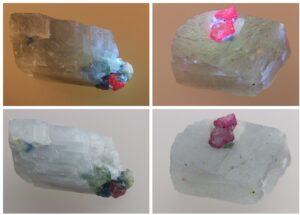Date/Time
Date(s) - 09/03/2022
7:30 pm - 8:30 pm
Categories No Categories
(venue opens at 7pm for socialising)
The Mogok Metamorphic Belt is known for its strongly fluorescent rubies, however there are many more overlooked UV-reactive mineral species. The mechanism behind the orange fluorescence in scapolite and feldspathoids, and photochromism/tenebrescence (color darkens and becomes deep purple) of hackmanite has been ascribed in the literature (1) to (Sn)x− species (n = 2 or 3; x = 1 or 2), trapped in the host lattice concomitantly with chlorine vacancies. Current research predominantly explores the interaction of light with matter using recent advances in TD-DFT modeling. While theoretical physical chemistry studies provide a fertile ground to decipher the phenomenon behind these optical oddities, there is still room to gain understanding of the geological mechanisms required to form these minerals present across a wide range of paragenesis. From metacarbonates to syenite, the geology of the Mogok Gem Tract offers diverse lithologies. Impure spathic marble, present in Dattaw mine, host numerous neglected sulfur-bearing species, with either sulfur as sulfate groups as part of the structure (Cancrinite, Davyne, Haüyne), or as trace substitution in scapolite group minerals (Marialite – Meionite series, Balliranoite). Silica-deficient pegmatites in Pyant Gyi and Pain Pyit localities host sulfur-doped sodalite, known as hackmanite.
This presentation will explore the properties of these UV-reactive species from an ore genesis, petrological, geochemical and material science perspective. The discussion will cover: 1) How could meta-evaporite lenses in the protolith explain the presence of sulfate/chloride in the mineralogical assemblages lead by feldspathoids? 2) What are the genetic implications for the nearby ruby deposits?, 3) What role for organic matter in enabling the reduction of sulfate to S2– , the activator dimer proven to be the cause of the yellow-orange fluorescence in scapolite? 4) What role for S3–, assumed to be responsible for the photochromism, and how can K40 radiation from neighboring micas and feldspars strengthen the intensity of the tenebrescence? 5) How do other mineral species in the paragenesis influence the optical properties of the S-doped sodalite? 6) How can Principal Component Analysis of multi-element data increase the understanding of this rare occurrence? 6) How is the daylight color of hackmanite linked to the intensity of its fluorescence?, and 7) What influence thermal and irradiative treatments have on the luminescence / fluorescence / tenebrescence of natural hackmanite?
An extensive suite of these calc-silicate fluorescent minerals from the collection of the author will illustrate the findings and conclusions.
(1) see Stoliaroff et al. 2021, Blumentritt et al. 2020, Colinet et al. 2020, Norbo et al. 2018, 2016, and Curutchet et al. 2016.


Nicolas Hebert is a geologist/engineer and mineral enthusiast. He graduated from Ecole Nationale Supérieure de Géologie, Nancy, France in 2018. Based in Perth, Western Australia, he presently works at the Dalgaranga gold mine, where his work encompasses exploration, resource development and production.
Previous presentations include “The Mineralogy of the gem-bearing marbles of SE-Asia : a journey from Luc Yen to Mogok” where he discussed social, financial, legal logistical issues faced while undertaking field expeditions in artisanal gem-mining areas, before exploring the reasons behind similar mineralogy in those two locales, and “Blue spinels” (at the 2020 Mineralogical Societies of Australasia Joint Seminar).
Even though primarily interested in mineral collecting in the Vosges and Alpes massifs, he took part in paleontological collecting expeditions in Svalbard and Wyoming respectively for MHNF (Fribourg, Switzerland), and the Senckenberg Museum (Germany). A significant part of Nicolas’ collection is focused on minerals from Mogok’s region and marble-hosted mineral associations.